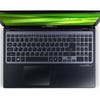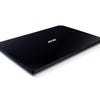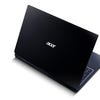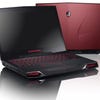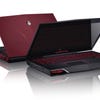Gaming Laptop Showdown: Acer Ultra M3 vs. Alienware M14x Review
Value Ultrabook takes on an ultra spec portable - with some surprising conclusions.
Dedicated laptop graphics cards rarely live up to the performance level of their desktop counterparts, meaning that many so-called gaming laptops simply can't cut it on more modern games - despite some lofty price-tags. In putting together this feature, we decided to test two of NVIDIA's less powerful laptop GPUs to see just what kind of experience you can get at the mid-range level on some of the PC's most demanding titles.
Step forward the Kepler-derived GeForce GT 640M and its more capable counterpart, the GT 650M. Both are essentially cut-down versions of the all-powerful desktop monster, the GTX 680, albeit with clock speed reductions and lower CUDA core counts. While the top-end desktop GPU weighs in with a mammoth 1536 processors, both of the mobile chips make do with a mere 384, while clock speed is reduced to 900MHz for the GT 650M and 650MHz with the GT 640M.
While this may sound like an enormous downgrade, it's worth bearing in mind a couple of mitigating factors. Firstly, in less expensive notebooks a 1366x768 screen resolution is commonplace. While this is often lambasted for being way too low for 15-inch laptops in the full HD era, it does have the virtue of reducing GPU power requirements, and in console terms there's still an extra 13 per cent of "bonus" resolution over standard 720p. Secondly, as we've explained in the past, graphical features often operate on a law of diminishing returns: there's a massive computational gulf between "high" and "very high", and there's a strong argument that certain visual improvements don't warrant the GPU cost, because in the heat of the action you may not notice the difference.
Certainly, Apple thought the GT 650M worthy of enough of inclusion in its new Retina-equipped MacBook Pro, which adds another dimension of interest to an analysis of its capabilities.
The Acer Timeline Ultra M3: Ultrabook Meets Kepler?
On paper, the Timeline Ultra M3 looks like a gaming combination that shouldn't really work. Acer has mixed an ultra-low voltage dual-core Sandy Bridge CPU - in our case the i5 2467M running at a paltry 1.6GHz (with turbo boost up to 2.3GHz, thermal limits permitting) - with a Kepler GT 640M. Our machine came with a mere 4GB of DDR3 memory, while the graphics core possesses its own gigabyte of dedicated RAM. That'll be DDR3 as well, not the more bandwidth-friendly GDDR5 we usually find attached to performance graphics cores.
The machine itself is intriguing. Acer calls it an Ultrabook - implying small, thin and light - but the unit itself is a 15-inch, 2kg monster, complete with onboard optical drive. The Ultra M3 barely scrapes into the definition of what an Ultrabook is supposed to be by virtue of a 1.9cm overall thickness and adherence to other Intel mandates including low-voltage CPU and SSD support.
There's a genuine sense of "make do" in the build quality, perfectly serviceable without pushing the boat out. There's a magnesium alloy lid, with the rest of the case built from polycarbonate giving a dull, charisma-free "black slab" aesthetic to the unit. There's an almost complete lack of the premium finish we usually find with Ultrabooks, but in fairness, it is functional where it matters. The chiclet keyboard performs well and there's no flex, but there's no backlight - a feature we would have liked to see. Screen quality is what you would expect from a bog standard TN panel at 1366x768, with some disappointing viewing angles. The power button is on the front and all major ports (HDMI, Ethernet, dual USB 2.0s and a high-speed USB 3.0) are on the rear - fine for desktop use but not particularly friendly for a laptop.
If it sounds like we're not too impressed with the unit, it's worth pointing out some of its strengths - and it has plenty. Firstly, battery life is pretty useful - you should be able to perform general browsing with reasonable screen brightness and the odd YouTube video for around seven hours, pushing that well beyond eight for browsing only.
Secondly, support for mSATA is a welcome feature. This means you can either use SSD caching to speed up your mechanical hard drive's response, or indeed install the whole OS onto the mini-form factor SSD, leaving the HDD for mass storage. One thing worth pointing out is that the hard drive itself can only be 7mm in height - standard 9mm 2.5 inch drives won't fit. Our review unit is a US model with a 500GB 5400rpm drive and a 20GB SSD, set up for HDD caching and fast power-up from hibernation.
The final plus point in the Ultra M3's favour is price. The base Core i3 1.4GHz model with no SSD retains the Kepler GPU and can be purchased for as little as £561, while our review unit (minus the SSD) costs £623. SSD variants are available but then you're looking at very high prices for a package that frankly isn't worth it. It's far more economical to get the i5/500GB model and simply buy a 30GB mSATA SSD for £43, which should adequately house the operating system, leaving the 500GB drive available for games, media and other more meaty files.
The New Alienware M14x R4
Facing off against the Acer is Alienware's refresh of its M14x platform, principally boosted with the inclusion of Ivy Bridge Intel processors (offering around five to 15 per cent speed increases like-for-like against Sandy Bridge) and support for Kepler and mSATA.
With the ultra-slim M11x being left out of the most recent revision of Alienware's laptops, the M14x takes its place as the brand's de facto mobile platform. Where the larger, weightier laptops are being positioned as outright desktop PC replacements, the M14x sets out to strike a balance between size, weight and connectivity to better suit gaming on the commute.
That's the idea in any case. The M14x does a great many things right where the now-retired M11x struggled, simply due to it being housed in a larger chassis that facilitates higher-performance parts. In our earlier review, gripes with the 11.6-inch model extended to its "washed out" TN LCD, uncomfortably cramped keyboard layout and the lack of an optical media drive, forcing all game installations to be made through digital distribution services (or an external drive).
Naturally, all these concessions are typical of netbook designs looking to maintain their petite form factor, but for an expensive, high-grade gaming laptop, these points ultimately compromise the user experience too greatly - something the M14x's larger form factor and superior screen largely resolves.
In terms of its physical interface, we have a full-size backlit keyboard to make use of, which greatly benefits hotkey-heavy games such as StarCraft 2, and means you won't be getting your fingers in a twist. The black, matte exterior is standard fare for the range - slightly rubbery to the touch, while the glossy surfaces contouring the keyboard and screen are as prone to being covered in fingerprints as before. As expected, the M14x's larger dimensions also afford it the option for a slot-loading DVD or Blu-ray player, though there's no room for a dedicated media panel above the standard keys; extra functions such as volume and screen brightness are accessed through the FN button, just as they are on the Acer.
The M14x starts with its higher-quality 14.1-inch 1366x768 screen being offered as standard, while an extra £40 allows for a higher-resolution 1600x900 alternative to be installed. The model we're sampling is packed in with the latter, and comes complete with an NVIDIA GT 650M 1GB graphics processor, 8GB of DDR3 RAM, and an Intel i7-3720QM CPU clocked at 2.6GHz. Such a rich spec comes at a price, of course. The base model costs £999 at the time of writing, while our review unit costs £1328 - pretty much twice the cost of the Acer.
Performance Analysis: Benchmarks
So far, so obvious. The comparison between the two units might almost be considered laughable. The M14x offers a substantial performance boost over the Acer in virtually every major area: a revised CPU architecture, two more cores, much faster clock speeds, double the RAM, and the same GPU architecture with a base clock speed bump of almost 40 per cent compared to the GT 640M. Not only that but this particular GT 650M comes with GDDR5 attached - offering potentially huge bandwidth advantages over the lowly Acer's DDR3.
Basic benchmarking should demonstrate that the gulf in overall spec, so let's get that underway, kicking off with staple favourite, 3DMark11.
"3DMark11 scores reflect the additional processing power of the Alienware CPU but overall GPU performance is much closer than we expected it to be."
Futuremark 3DMark 11: Tested on standard Performance and Extreme settings.
| Acer Ultra M3 (Perf) | Alienware M14x (Perf) | Acer Ultra M3 (Extreme) | Alienware M14x (Extreme) | |
|---|---|---|---|---|
| Graphics Score | 1748 | 2101 | 531 | 653 |
| Physics Score | 2778 | 8376 | 2748 | 8302 |
| Combined Score | 1506 | 1871 | 679 | 876 |
| 3DMark 11 Score | P1819 | P2334 | X591 | X740 |
In theory, GDDR5 vs. DDR3 is no contest, memory bandwidth should be much, much wider. Yet curiously in our graphics scores, we see a difference mostly attributable to the clock speed alone. Elsewhere, the strength of the Alienware platform is more obvious. That quad-core CPU offers an enormous boost for the physics and combined test scores, leaving the Ultra M3 far behind in its wake.
Next up, we return to our other standard benchmarking runs, this time using performance analysis tools built into actual games. Rocksteady's brilliant Batman: Arkham City is our first subject: settings are reduced compared to our top-end GPU tests; resolution is adjusted to 1366x768, PhysX is left disabled, and minor downgrades are made to the overall settings, though detail level is set to high and all other effects are turned on.
We also selected varying levels of anti-aliasing: the higher the MSAA level, the more we should see the advantages of the Alienware's GDDR5 win out over the DDR3 in the Acer. High-quality FXAA, which works beautifully in this game, was also factored in. First up, we used the DX9 mode which generally runs a lot faster than its DX11 equivalent. It's worth factoring in that the minimum FPS results in this bench seem to be entirely related to hard drive performance, which can vary depending on background OS tasks.
Batman: Arkham City Benchmark: DX9, 1366x768, high detail, PhysX off, all other settings enabled.
| Acer Ultra M3 (FXAA High) | Alienware M14x (FXAA High) | Acer Ultra M3 (4x MSAA) | Alienware M14x (4x MSAA) | Acer Ultra M3 (8x MSAA) | Alienware M14x (8x MSAA) | |
|---|---|---|---|---|---|---|
| Average FPS | 55 | 92 | 48 | 86 | 38 | 70 |
| Min FPS | 28 | 52 | 21 | 47 | 16 | 32 |
| Max FPS | 55 | 110 | 48 | 110 | 38 | 91 |
We see a clear performance boost from the Alienware over the Acer, and the gulf between the stats widens the more multi-sampling anti-aliasing we use, entirely as we would expect as the bandwidth advantages of GDDR5 come to the fore. But considering all the disadvantages the cheaper machine has, the fact is that the stats strongly suggest that you can enjoy Batman: Arkham City at the native resolution of the panel with excellent anti-aliasing, and still get something very close to a 60 frames-per-second experience.
With the M14x, we should be able to move beyond the "high" detail preset and go into more extreme territory, but the question is - just how much more noticeable will that actually be during the run of play? Is it enough to justify paying so much more for the privilege?
Perhaps of more interest is how the machines cope when switching to the DirectX 11 renderer. Tessellation is introduced (we'll stick to the default "normal" level), and we see more ambitious effects work including multi-view soft shadows and horizon-based ambient occlusion.
"Batman: Arkham City benchmarks reflect the advantages of GDDR5 over DDR3, but you can still enjoy a high-settings 60FPS experience on the lower-spec Acer laptop."
Batman: Arkham City Benchmark: DX11, 1366x768, normal tessellation, high detail, PhysX off, all other settings enabled.
| Acer Ultra M3 (FXAA High) | Alienware M14x (FXAA High) | Acer Ultra M3 (4x MSAA) | Alienware M14x (4x MSAA) | Acer Ultra M3 (8x MSAA) | Alienware M14x (8x MSAA) | |
|---|---|---|---|---|---|---|
| Average FPS | 33 | 56 | 28 | 51 | 21 | 36 |
| Min FPS | 1 | 27 | 3 | 4 | 3 | 16 |
| Max FPS | 48 | 70 | 43 | 66 | 33 | 46 |
The introduction of the additional rendering load impacts frame-rates by at least 40 per cent. The faster clock speeds and bandwidth of the GT 650M still allow for a 60FPS gameplay experience, and while the Acer's less privileged GPU can still run the game at a playable 30FPS, the additional refinements aren't really worth the price of admission. However, there is the suggestion that the more powerful Alienware is better equipped for the additional demands future games will inevitably place upon the hardware.
Next up, the particularly brutal Metro 2033 Frontline in-game benchmark. At maximum settings and 1080p res, even the GTX 680 struggles to hit an average 30 frames per second, so to give the lower-end hardware a bit more of a chance, we dropped detail to the medium level and disabled the performance-sapping PhysX simulation.
Again, we ran the same test twice over - first with 4x multi-sampling anti-aliasing enabled, and then with 4A's custom "AAA" post-process.
Metro 2033 Frontline Benchmark: DX11, 1366x768, medium detail, PhysX disabled.
| Acer Ultra M3 (AAA) | Alienware M14x (AAA) | Acer Ultra M3 (MSAA) | Alienware M14x (MSAA) | |
|---|---|---|---|---|
| Average FPS | 21.33 | 29.40 | 17.33 | 24.94 |
| Min FPS | 9.99 | 8.90 | 6.79 | 9.54 |
| Max FPS | 45.10 | 51.46 | 35.34 | 40.82 |
With the settings dialled down, the GT 650M makes a good fist of something that would be a playable frame-rate - with MSAA disabled, at least. This demanding benchmark really makes mincemeat of the poor old GT 640M - something we would hope won't be so pronounced during actual gameplay.
So if pure synthetics give us some idea of raw capabilities, and gaming benches allude more closely to real-life performance, that just leaves actual gameplay. We prefer to stick to our own tests on selected titles to see how well these technologies match up to our specific requirements for a premium PC experience.
We're looking for a mixture of accomplished image quality, no screen-tear, and high, console-beating frame-rates. The adherence to v-sync in particular is a challenge: it caps frame-rates to 60FPS, while dropped frames are more keenly felt in controller response as you don't receive your next image on-screen until the next vertical refresh on the display. We would have liked to have used NVIDIA's adaptive v-sync tech to cap at 60FPS and tear beneath, but curiously this does not appear to be a function of the mobile Kepler tech - a somewhat confusing state of affairs since there is no technical reason why it should not have been implemented.
Gameplay Analysis: Skyrim
First up, The Elder Scrolls 5: Skyrim. The game's intro offers us an excellent opportunity to compare system performance as it allows us to render almost the exact same scene multiple times over. We found that engaging the high-quality preset - which features 8x MSAA and 8x anisotropic filtering (AF) along with good view distance and a lot of effects - was a good place to start, and found that the overall level of image quality easily bested what we were used to with the PS3 and Xbox 360 versions while offering improved, more consistent performance.
Sky-high frame-rates aren't exactly a must for an RPG like this but with both machines keeping north of 30 frames a second with a decent amount of visual features, the game simply feels richer and classier compared to the console versions. The GT 650M in the Alienware machine appears to operate with a 40 per cent frame-rate advantage over the Acer's lower-spec GPU - a state of affairs that remains constant throughout the entire clip. Indeed, the M14x can be ramped up to ultra quality levels and still marginally outperform the Acer, so long as you drop MSAA down to 2x.
"Both laptops offer an excellent Skyrim experience at high-quality settings, with the M14x offering the choice of higher frame-rates or ultra-level visuals depending on your choice."
Achieving a locked 60FPS would see some pretty savage quality reductions for the lower-specced machine (a mixture of low and medium settings), but the M14x achieves it by sticking with the high preset, and swapping out MSAA in favour of post-process FXAA. This adds some blur to the textures, but the additional smoothness is welcome.
Overall, first impressions of our test units in this initial gameplay analysis are highly favourable. Skyrim worked very well on both platforms and the M14x in particular impressed owing to the higher-quality options available with the added processing power on tap. But do we see a level of performance that warrants the huge increase in price? At this point in our tests, the jury was out.
Gameplay Analysis: Battlefield 3
Next up, a return to more familiar ground with DICE's stunning Battlefield 3 - one of the most visually impressive titles available on PC. We opted for the medium quality level in this particular test after a quick series of tests with the Acer - from our initial tests, we found that the level of visual accomplishment easily outstripped the console versions and frame-rates seemed favourable too. We're not making this analysis easy though: the fire fights in the Operation Swordbreaker level are far more strenuous on the system than virtually any multiplayer level, and performance can get choppy indeed.
Here's where we encountered our first real gripe with the Ultra M3. DICE's title does a lot of on-the-fly texture decompression and we found that the plucky Acer would momentarily pause sometimes during gameplay - at points where we felt sure background loading was taking place. Were we encountering problems with the weak CPU? The system had been supplied to us having been used elsewhere, so we went to the recovery tools and reinstalled the whole OS, updating the graphics drivers in the process.
"Battlefield 3 response seemed significantly laggier on the Acer, the suggestion being that the low power dual core CPU was bottlenecking overall performance."
The result was a significant improvement, but you'll note that there are situations where the frame-rate still dips, decoupling from the general trend of difference we see up against the Alienware machine. Even mirroring this fresh recovery image onto an SSD made no discernible difference and we still have the nagging suspicion that something may be a bit off with this particular machine.
The general performance differential comes in at around 12-14 FPS between the two systems, but you'll note that in intense combat, the gap widens - Battlefield 3 thrives on a quad-core CPU and even though the ultra-low voltage Core i5 in the Acer can turbo up to 2.3GHz if there's thermal headroom, there is the suggestion that the drops in performance we saw are the result of being CPU-bound. Over and above that, the Ultra M3 simply cannot get anywhere near 60FPS even with all settings at the lowest level - again suggesting it is the CPU that is the bottleneck here. The M14x has better luck - by adjusting shadow and mesh detailing, we found most of the extra performance to give a perceptual 60FPS effect. Outside of the testing Operation Swordbreaker stage, settings can be increased without so much of a hit on performance.
Gameplay Analysis: Crysis 2
Finally, Crytek's technological tour de force. Again starting with the Acer Aspire Timeline Ultra M3, we found that performance was decent at the mid-range setting (dubbed "very high" by Crytek) even with the DX11 features engaged and the high-quality textures turned on.
Squeezed into a 1366x768 framebuffer, the overall level of presentation is far richer and much more consistent than the console games, with a beautiful sheen of post-process polish. What works well on the Acer clearly performs even better on the more expensive M14x, and in exact like-for-like scenes, we see the biggest gulf in general frame-rates.
"Once again, the M14x offered more options for higher-quality settings, but the very high DX11 preset worked well on both machines and is a clear leap beyond quality of the console versions."
It's difficult not to feel that once again we're somewhat CPU-bound here on the slower Acer. The closest we got to 60 frames-per-second was to switch to the DX9 renderer, drop down to "high" settings - equivalent to console in many respects - and even then we're still looking at around 35-50 frames per second. Overall though, Crysis 2 is running at frame-rates that consistently outstrip the console versions, with far more effects and more highly detailed artwork in play. It loses some of its sheen by not running at 60FPS, but it's still a superior experience overall.
While performance is still variable, the M14x gives us a console COD-style "perceptual 60FPS" where frames are still being dropped but you can tangibly feel the smoother frame-rates and the handshake between player and game is much improved.
Screen Options: 1366x768 vs. 1600x900
While we've concentrated on 1366x768 resolution for the bulk of the analysis work, the fact is that the Alienware M14x has a 1600x900 screen option, and luckily for us it's fitted on our review unit. Clearly it's not quite up to the same level as the full HD 1080p screens we see in the firm's larger laptops, but it's a good middle-point, better suited to the less powerful GT 650M graphics core while making general usage in Windows a significantly better experience. As a £40 upgrade, it's a no-brainer.
While you can run games at lower resolutions, upscaling on laptop LCD panels never really works out particularly nicely. Up close and personal, with the screen right in front of your face, native resolution really is a must. That being the case, we re-ran the gameplay performance analyses, comparing the two options. Here's how Battlefield 3 worked out, while further analyses of Skyrim and Crysis 2 are also included.
"The Alienware's option for a higher resolution display is a welcome response to claims that 1366x768 just isn't good enough for today's laptops."
Factoring in that we're looking at a 37 per cent boost in resolution, the overall impact to frame-rates is bearable - in like-for-like scenes, the difference is just 6FPS in our Skyrim test, around 10FPS in Battlefield 3 and in the region of 12FPS with Crysis 2. The impact is noticeable in the shooters, providing an overall experience somewhat similar to what we saw on the GT 640M in the Acer Ultra M3, and could most likely be mitigated with further options tweaks.
Acer Timeline Ultra M3 vs. Alienware M14x: The Digital Foundry Verdict
The Alienware M14x achieves pretty much everything you would expect it to and ranks as an accomplished mobile games machine with a good screen and accomplished build quality. However, all of this comes with the expected premium price-tag, and we weren't particularly blown away by the battery life (about 3.5 hours in general browsing with a spot of YouTube, up to five if you're really, really careful), while the grating fan noise while gaming proved annoying to the point where headphones became a must.
By contrast, the Acer Timeline Ultra M3 is clearly built to a cost, is a little unwieldy in terms of sheer bulk, has a poor display and can get brutally hot when the GPU is engaged at maximum warp for any length of time. The amount of crapware installed on the machine by default is also remarkably off-putting to the point where after using the recovery discs, an auto-installer wastes about 15 minutes of your life by cluttering up the machine with these mostly unwanted programs. You then need to spend the same amount of time again uninstalling them - thanks for that.
"Both machines offer plenty of plus points for their respective price-tags, but the disappointments suggest that NVIDIA's Kepler tech may yet find a better home elsewhere."
We were also perturbed by mysterious dips in performance during gaming: try as we might to mitigate the issue - even by reinstalling Windows and using an SSD - disc access seemed to cause some impactful lag on certain games. It's not been mentioned on other reviews and even after a couple of weeks with the unit, we still have the nagging feeling that something's not quite right with it.
The Ultra M3 does have plenty of plus points, however: its stamina is great, its price point is reasonable, mSATA support is really useful and the fact is that blips aside, the overall gameplay experience is a step beyond that of the current-gen consoles. With careful tweaking of settings, you can enjoy some high-quality gaming here, despite its technical drawbacks.
In terms of the NVIDIA side of the equation, we were mystified by the lack of adaptive v-sync, which allows you to set a frame-rate cap and only drop v-sync when performance dips below the target (exactly what you see on a majority of console games). Particularly with the Acer running titles like BF3 on demanding settings, the ability to lock at 30FPS and tear below would have made a huge difference to the overall consistency of response in testing conditions. Quite why the tech has not been implemented doesn't make much sense. The desktop GT 640 - to all intents and purposes a GT 650M with DDR3 - apparently has it, so why not the mobile cards?
Overall, our time working with these laptops has proved illuminating in terms of the graphical capabilities of more cost-effective rendering hardware. Bearing in mind the enormous gulf in specification between the two units, you might expect the Alienware M14x to annihilate the Acer, but actually it puts up a fairly strong challenge bearing in mind how completely and utterly outgunned it is in virtually every area of the spec.
In the modern gaming era, it seems to be almost a given that quad-core power is a must - but if a 1.6GHz mobile part performs so well, what would happen if these experiments were repeated with something like the £55 Pentium G840 (a dual-core Sandy Bridge clocked at 2.8GHz) and the £70 Radeon HD 6770? There's the enticing prospect of some excellent 720p performance on a machine you could build for under £300 - something we now feel strongly compelled to look into.
Returning to the topic at hand: Alienware or Acer? If you're in the market for a gaming laptop, each has its own charms at their respective price points, but both units have fundamental weaknesses in their overall make-up - the capabilities of the mobile Kepler shine though, but with neither product truly convincing we can't help but feel that the best home for NVIDIA's new tech may well rest in another product.



